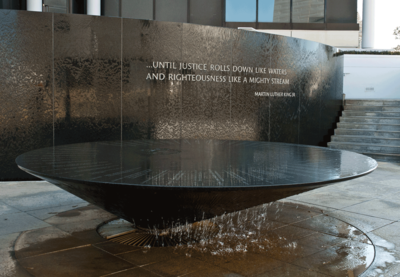The memorial itself is simple: a round slab of black granite the size of a large table and, behind it, a wall of the same stone. Carved into the slab, like second marks on a clock, are important dates and events in the civil rights movement, beginning with the Brown ruling and ending with Dr. King’s assassination. There are also 40 names: martyrs killed in the Deep South between May 17, 1954, and April 4, 1968.
In the center of the table, water bubbles up as if from a spring. It flows over the names and drips onto the ground beneath the slab. Water flows over the wall, too, and over the phrase carved into it: “ ... until justice rolls down like waters and righteousness like a mighty stream.”
When the Civil Rights Memorial was dedicated in 1989, it was the first memorial to the martyrs of that movement in the United States. Commissioned by the Southern Poverty Law Center, the monument is in downtown Montgomery, Alabama, a city filled with landmarks of the civil rights movement. Maya Lin, the architect behind the Vietnam Veterans Memorial, agreed to design it. “I knew little about the civil rights movement,” she later wrote. “I was shocked by what I learned, but I was even more disturbed that the information I was learning about our history—events that were going on while I was growing up—was never taught to me in school.”
Lin turns 60 on October 5, and it’s heartening to know that the stories she never learned are now taught in schools across the nation—and that she had a part in that change.
You have a part in that change, as well.
Every year, hundreds of students visit the Civil Rights Memorial. They place their hands on the slab and run their fingers over the names. They press their palms against the wall, just beneath the quote from Dr. King, and feel the water flow.
… until justice rolls down like waters and righteousness like a might stream.
This description isn’t rhetorical flourish—I know this because I see them. Teaching Tolerance’s main office sits within walking distance of the memorial, and it’s not unusual to find one or more of our staff watching a class come or go. The children bounce across the grass until they reach the memorial, and then they become still; they become quiet.
It’s clearly a sacred space, a place to remember and honor those who fought for justice, those who died at the hands of hate. And we’re grateful to the educators who can bring their students to be part of it. You and your students inspire us more than you know. But we also recognize that there are many of you who can’t make the trip, who we only see rarely, if ever.
We hear from you sometimes, when you write to us or stop by and visit with us at a conference. You tell us about the work you’re doing with students, how you’re teaching the history Lin never learned. You tell us about how you’re working with children to imagine a world without white supremacy, how you’re committing yourself to teach the hard history of American slavery, how you’re remembering other martyrs. You remind us, as current TT Advisory Board member Jamilah Pitts wrote a few years ago, that “teaching as an act of resistance and teaching as an act of healing are not mutually exclusive.”
Sometimes we hear how alone you feel. We hear how you might be the only person in your school, in your district or town who is doing this work. But we also hear that you won’t stop. We hear how committed you are, how you know that being the only one makes you all the more necessary.
At the memorial, the ground slopes gently toward the base of the slab, where the water collects to make its journey again. But on rainy days, when the ground appears as dark as the granite, it’s harder to trace the path the water takes. Those days, it’s impossible to see where the sacred space of the memorial ends. The sparkling grass is a part of it, for sure. The wet roof of the nearby Dexter Avenue King Memorial Baptist Church, where Dr. King once pastored, is a part of it as well. So are the bus stops left empty during the boycott, the state capitol where the march from Selma ended, the Rosa Parks Museum and the Memorial for Peace and Justice across town. All these sacred spaces are connected.
You inspire us as you do necessary work in your own context. When you tell us about the sacred spaces you’ve built in your schools or your classrooms. When you tell us how you teach about Black Lives Matter, how you support undocumented students and their families. When you share your fight against the mistreatment of your LGBTQ students, the diminishment of your students with disabilities, the erasure of our shared hard history.
That’s what we want to tell you: that you inspire us, along with your students. That you are not alone. That all of the sacred spaces are always connected.
Delacroix is the interim senior editor for Teaching Tolerance.
